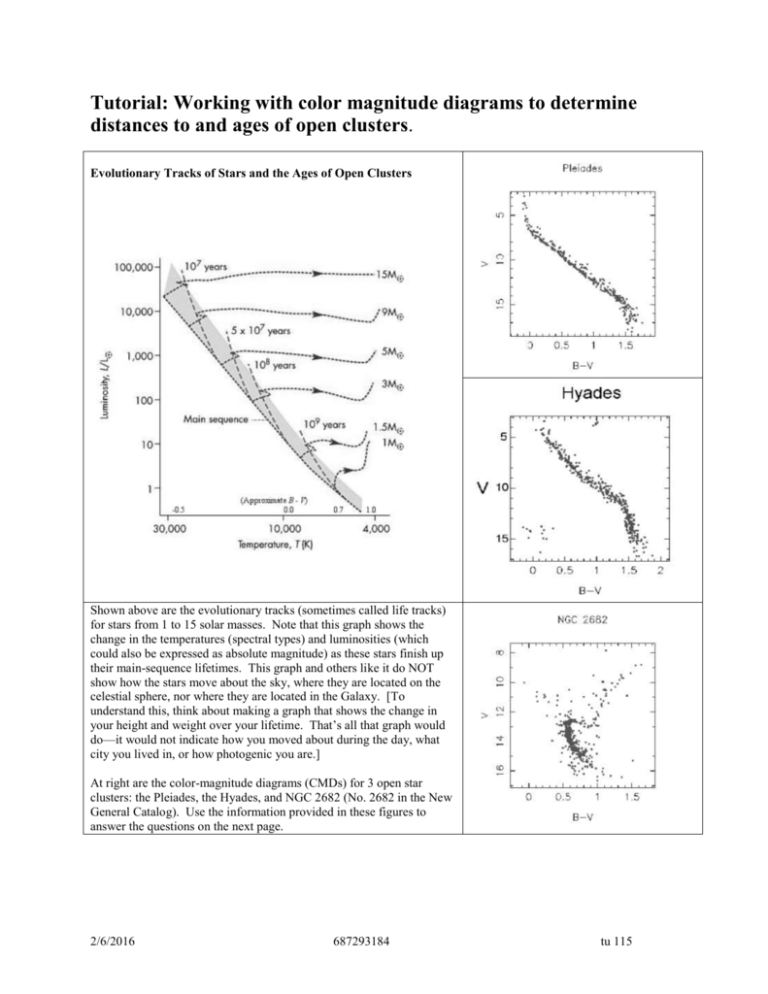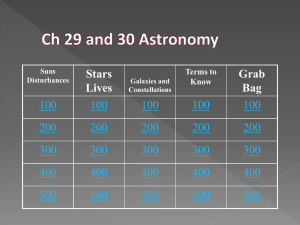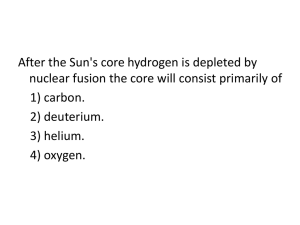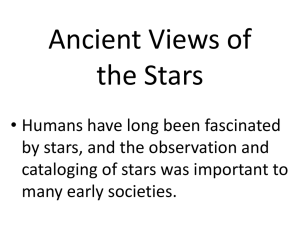Tutorial for working with color magnitude diagrams to determine
advertisement

Tutorial: Working with color magnitude diagrams to determine distances to and ages of open clusters. Evolutionary Tracks of Stars and the Ages of Open Clusters Shown above are the evolutionary tracks (sometimes called life tracks) for stars from 1 to 15 solar masses. Note that this graph shows the change in the temperatures (spectral types) and luminosities (which could also be expressed as absolute magnitude) as these stars finish up their main-sequence lifetimes. This graph and others like it do NOT show how the stars move about the sky, where they are located on the celestial sphere, nor where they are located in the Galaxy. [To understand this, think about making a graph that shows the change in your height and weight over your lifetime. That’s all that graph would do—it would not indicate how you moved about during the day, what city you lived in, or how photogenic you are.] At right are the color-magnitude diagrams (CMDs) for 3 open star clusters: the Pleiades, the Hyades, and NGC 2682 (No. 2682 in the New General Catalog). Use the information provided in these figures to answer the questions on the next page. 2/6/2016 687293184 tu 115 1. Give an overall qualitative description of how the temperature and luminosity of a star that has 15 times as much mass as the Sun changes in temperature and luminosity as it leaves the main sequence. 2. Give an overall qualitative description of how the temperature and luminosity of a star that has the same mass of the Sun changes as it leaves the main sequence. 3. Fill in the following table: Cluster MS Turn-off B – V (approx) MS Turn-off Temperature Approx. age of the cluster Approximate mass of stars at turn-off Pleiades Hyades NGC 2682 4. Why do CMDs look the way they do? We see a “time-frozen” picture for each of the clusters plotted in the right-hand-side figures. The Pleiades are the youngest of these 3 clusters, probably a few 10’s of millions of years old, as it appears that all of the stars—even the most massive ones—are still on the main sequence. The turn-off for the Hyades is between B –V = 0.0 and 0.5, and so these stars are probably around 1 billion years old; the cluster has had enough time that some stars have evolved clear to the white dwarf stage. NGC2682 is by far the oldest. The turn-off is around B – V = 0.6. This cluster has stars that are close to 1 solar mass leaving the main sequence, meaning that these stars are around 10 billion years old. Give the life-tracks for stars of different masses in the left-hand-side figure above, do these CMDs make sense? Explain. The Hyades and the Pleiades Open Clusters Here is a negative image of how the open clusters the Hyades and the Pleiades look in the night sky, showing their relative positions and apparent sizes in the constellation of Taurus. By just looking at them with the naked eye, there is no way to tell which cluster is farther away, and certainly no way to tell how much farther away that cluster is. But, by using the apparent magnitudes of the stars in each of these clusters (especially those stars that are on the main sequence), astronomers can determine their relative distances. If we knew the actual distance to one of the clusters, say by an independent method, then we would know the actual distance to the second cluster. tu 116 We start by observing each cluster through different filters: one centered on blue wavelengths (B), and the other centered on visible (V, roughly yellow) wavelengths. We then compare the magnitudes registered through each filter (B – V, or the color index), and plot the results. Within each plot, we are comparing each star to other stars in the same cluster. For open clusters, we assume that all of the stars in each cluster were born at roughly the same time (they are all the same age) and from the same giant molecular cloud (they all have roughly the same composition). Thus, the only difference among the stars in any given cluster is the mass of each star. In order to compare one cluster to another, we must decide which stars are suitable for comparison. The stars on the main sequence are the most reliable because we can assume that at a given mass, stars are roughly at the same luminosity and temperature. We pick B – V = 1.0 (temperature approximately 4500 K). Relative distances to each cluster Here we want to just get a rough idea of the relative distances to each of these clusters. We start at B – V = 1.0, go vertically until we meet the “bottom” of the main sequence at that color (think about drawing a line underneath all of the points representing the stars on the main sequence) and then read off the corresponding “V” magnitude (this is the apparent magnitude measured through the V filter). We note that for the Hyades, V = 10, and for the Pleiades, V = 12. These two magnitudes are approximate. Because of our novice status in this work, our estimated uncertainties give us a range of + or – 0.5 magnitudes for each V magnitude (range for the Hyades is 9.5 < 10 < 10.5; for the Pleiades, 11.5 < 12 < 12.5). tu 117 Right away, we know that the Pleiades is farther away than the Hyades, because stars at a given temperature are dimmer. Since we logically assumed these stars should be the same luminosity, the reason that they are dimmer is that they are farther away. What is the relative distances between these two clusters? Compare the V magnitudes of the Pleiades versus the Hyades at B – V = 1.0: 12 – 10 = 2 magnitudes. Since each difference of 1 magnitude corresponds to a luminosity (intensity) ratio of 2.512, the stars in the Pleiades are about 6.3 times dimmer (2.512 2). The apparent brightness – luminosity – distance formula tells us that the Pleiades must be about 2.5 times farther away (just reverse the logic in this case, and round off). Additional examples for understanding: let’s assume that instead of 2 magnitudes difference, there were actually 3 magnitudes difference. This means that the stars in the more distant cluster would be 2.512 3 = 15.85 times dimmer. This would correspond to a relative distance of almost 4 times farther away (square root of 15.85). Let’s say there are 5 magnitudes difference between two clusters as measured at a B – V = 1.0. Then, this means that the more distant cluster is 2.5125 = 100 times dimmer, or 10 times farther away. Absolute distances to each cluster Through a number of different methods, astronomers have determined that at B – V = 1.0, the absolute magnitude of the main sequence stars of the Hyades is 6.6. With an apparent magnitude (as determined here) of 10, this places the Hyades at a distance of about 48 parsecs. d 10 mM 5 5 10 106.65 5 10 8.4 5 101.68 47.86 Using this number and the relative distances determined above, we find the Pleiades are 48 * 2.5 = 120 pc away. The current values for the distance modulus to the Pleiades range from 5.3 to 5.6 corresponding to distances of 115 – 132 pc away. That is about as certain as the distance to the Pleiades is at the moment, despite the best attempts by different teams of astronomers! Our value determined here, especially considering our uncertainties, puts us in great agreement with the best astronomers! tu 118 Determining the ages of these open clusters The Hyades star cluster is closer to the Sun (Earth), but is it older or younger than the Pleiades? There are a number of ways to determine the age of a cluster, the primary one being the age of the stars that are just “turning off” of the main sequence. Theory tells us that stars have a limited life fusing hydrogen to helium in their cores. The lifetime depends on the mass of the star—the more massive the star, the shorter the lifetime. Let’s look at this in two different ways: A table, and a diagram. Spectral Color Lifetime Type (B-V) (years) O –0.4 < 106 B –0.2 3 × 107 A 0.2 4 × 108 F 0.5 4 × 109 G 0.7 1 × 1010 K 1.0 6 × 1010 M 1.6 > 1011 These values are all approximate! Given the information above for the Hyades, we find that this cluster has a turn-off at about B – V = 0.1. This means that stars between spectral types A and B (temperatures of around 10 – 15,000 K) are evolving off of the main sequence. Age = about 4 × 108 For the Pleiades, we find the turn-off at about B – V = –0.1. This means that stars closer to temperatures of 15 – 20,000 K (maybe B5 or so) are evolving off of the main sequence. Age = about 108 years tu 119 Take a closer look at the following diagrams and note how the “turn-off” of the main-sequence has been determined for each cluster. Think about taking a “vertical line” and, starting at the y-axis, move the line horizontally until it runs up against the place where there are the hottest stars—still some on the main sequence, but also some in the sub-giant region of the H-R diagram. After reviewing the turn-off, rank these clusters from oldest to youngest. Compare your answers to the key at the bottom of the page. tu 120 TO = 0.0 TO = – 0.05 TO = + 0.15 TO = + 0.03







